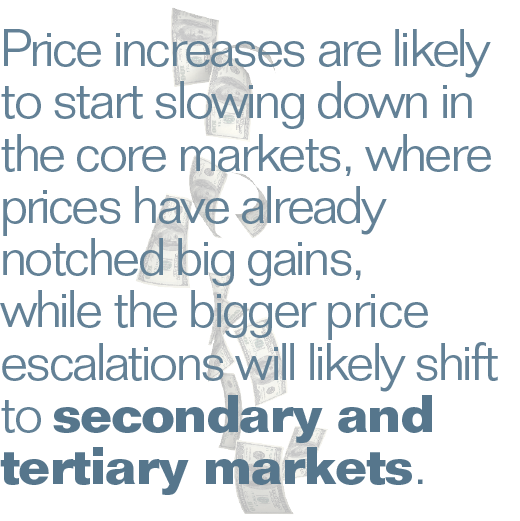Investors are proving that they are willing to open their wallets wider to buy properties in a highly competitive market.
Last fall, PNC Place in Washington, D.C. set a new high watermark price for the office sector when the office tower sold for $392 million or $1,075 per sq. ft. And just last month, OneEleven, a luxury 60-story apartment building in Chicago, sold for $328.2 million or $651,000 per unit. The price is reportedly the highest ever paid for an apartment building of more than 50 units in that city. The story is the same in major metros across the country. Sale prices, particularly for top assets, are setting new record highs.
Prices for commercial properties rose an average of 14 percent during the first nine months of 2014, and are poised to push even higher in 2015, according to a new report “Expectations & Market Realities in Real Estate 2015—Scaling New Heights,” which was published jointly this month by Real Estate Research Company (RERC), Situs, Deloitte and the National Association of Realtors.
Office properties recorded the biggest price jump at 19 percent and have now moved to a level that has exceeded their 2007 price peak. Prices on industrial and retail assets rose 14 percent and 13 percent respectively. Average apartment prices have also surpassed their 2007 price peak with further price gains of 12 percent during the first nine months of 2014, while hotel prices rose 5 percent, according to the report.
 The abundant capital in the marketplace, coupled with the low interest rate environment and still attractive yields, are expected to continue to fuel demand and higher prices. “I think 2015 is going to be one of the strongest years for commercial real estate that we have seen since the credit crisis, and it is going to happen for the right reasons,” says Ken Riggs, president of RERC. Riggs presented the report’s findings in a Feb. 5th webcast. The report outlook is for ongoing price increases over the next 12 to 18 months.
The abundant capital in the marketplace, coupled with the low interest rate environment and still attractive yields, are expected to continue to fuel demand and higher prices. “I think 2015 is going to be one of the strongest years for commercial real estate that we have seen since the credit crisis, and it is going to happen for the right reasons,” says Ken Riggs, president of RERC. Riggs presented the report’s findings in a Feb. 5th webcast. The report outlook is for ongoing price increases over the next 12 to 18 months.
Behind the numbers
Basic supply and demand principles certainly support additional price hikes. Capital continues to flow into the U.S. real estate sector from a myriad of sources, including global pension funds, sovereign wealth funds, private equity firms and REITs, among others. In fact, commercial real estate services firm JLL estimates that the ratio of investment capital to available properties for sale in the Americas during 2014 was about 13 to 1.
Yet at the same time, there is no “stupid money” out there, says Steve Collins, president of capital markets at JLL. “Investors are all doing their research, and it is very transparent in terms of how things are working now,” he says. Investors are concentrating on yields that can be achieved given the low-interest rate environment. As long as the debt markets continue to be accretive, meaning if an investor can buy a property in New York City that yields 4 percent with 3 percent capital costs, it still works. “When it gets to be the reverse, it starts to be a bit of a problem,” Collins adds.
That being said, price increases are likely to start slowing down in the core markets, where prices have already notched big gains, while the bigger price escalations will likely shift to secondary and tertiary markets, notes Collins. In major metros such as New York City, Boston, Washington, D.C. and San Francisco, there is still room for sale prices to tick higher. But those prices are not going to be running up as fast as in other markets, such as San Jose or Silicon Valley or Houston.
During the run-up before the recession, there was a frothy investment market with too much capital chasing too few deals. There is some concern that capital may become too aggressive again.
“Ultimately, the most important question for everyone is how are values and prices aligning in the marketplace,” says Riggs. According to a third quarter institutional investment survey by RERC and Situs, investors do believe that their returns are more than keeping up with the amount of perceived risk.
In 2008, the drop in value from peak to trough was 29.31 percent, but properties have gained back 44.21 percent in values, according to the report. In 2014, institutional real estate on an un-leveraged basis provided a 12 percent total return, according to NCREIF. “If you laid leverage on that, you’re talking about returns of roughly 15 to 18 percent, and you’re talking about a hard asset,” says Riggs. “So commercial real estate has provided a very high gross return.”
Those returns, coupled with improving fundamentals, will continue to fuel buyer demand in 2015.
“Our outlook from ‘Scaling New Heights’ is that we are going to continue to see record prices in 2015,” says Riggs.

